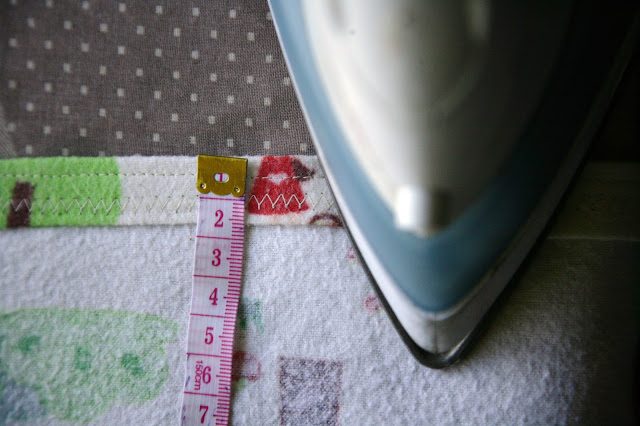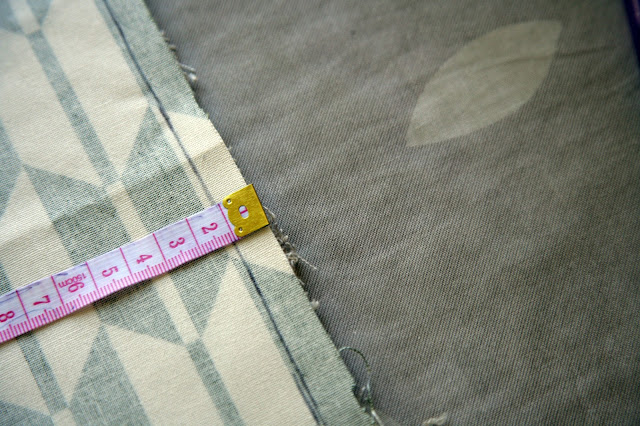Fabric
Complimentary or Contrasting Thread
Sewing Machine
Needle
Elastic
Measuring Tape
Safety Pin
Pins
Iron
Difficulty:
Easy
Time:
About an hour
First, select your fabric. You can buy new material or use second hand, depending on what you like and how lucky you get if you're thrifting. If you have a nice sheet that you don't use anymore, you can also cut this up and make about four sheets with it, usually with some to spare. I've used flannelette for mine but plain cotton works beautifully too. You might want to measure your bassinet mattress before you go shopping to see exactly how much you will need, but I took the lazy approach and estimated when I was in the store; the excess has been used to make reusable wipes.
Wash and dry the fabric first up if it's new to allow for any shrinkage - you don't want to make the sheet to size only to find out it shrinks too small after it's first cleaning session. You can then iron the fabric to make it nice and flat and easy to use.
Now, to get the fabric size that you need, you can do this one of two ways. If you want to know the size you need before you go shopping, you'll need to do some measuring. Find out the length and the width of your mattress first of all. Then, measure the depth of the mattress, add this twice (once for each side) to the above numbers. Finally, add at least 10cm to each side of this (20cm all up) to allow for the seams and cloth that will gather underneath the mattress. So if your mattress is 90cm long x 45cm wide x 5cm deep, then the size you need would be:
Length 90cm + 10cm + 20cm = 120cm
Width 45cm + 10cm + 20cm = 75cm
If you already have your fabric, you can lay down the mattress and add the depth of the mattress plus 10cm to it. In the case of the measurements above, you would need to measure out 15cm on each side of the mattress to get the right size.
*Note* You can add more than 10cm for seams and gathering if you like, depending on how much you would like it to gather underneath.
To get the corners curved, I simply marked out a few points using the ruler and drew a curve free hand. Once the sewing is all completed, you won't notice if you've done a slightly dodgy job with this!
Lightly trace around this shape using chalk and cut it to size.
Fold over approximately 1cm of fabric all the way around the edge and iron it flat. You can mark the distance with chalk but I did this by eye. You can pin the areas where there are little folds to ensure that the sewing goes easier there, and it's worth noting that I iron around the seam in the same direction that the sewing machine will go around it. This is so that the folds are all going in the same direction and will be easy for the machine to run over them - if you iron in the opposite direction, it will be a bit of a pain to sew over each one, as they will try to fold back the other way. Thenzig zag stitch to finish it off.
*Note* This step is optional. I like to have the sheet double hemmed to make it look nice and neat and 'finished', but you can leave it out if you want to save time or if you're worried your fabric won't be big enough and you don't have that cm to spare.
Fold over another 1.5 - 2 cms all the way around and iron flat. Again - you can mark the distance with chalk, but I did it freehand.
The important thing to remember here is that you will need to fit your elastic in the gap that is left after you sew a seam, so if you've bought wider elastic then you may need to make a wider seam. You can pin the little folds in the corners again, which I definitely recommend for this seam as it will be the one that you see once the product is finished - may as well make it nice!
Sew around the seam with a straight stitch, nice and close to the edge (furthest from the fold) leaving an unsewn gap big enough for you to slip the elastic into later - about 5cms is plenty. Optional: Go around again with a zig zag stitch, to reinforce it and to cover up any dodgy sewing (which is bountiful in my sheet!) again making sure you leave the gap to put the elastic through.
The amount of elastic you need can depend on how much excess fabric you added to your measurements at the beginning, and how tightly you would like the sheet to fit. As a rule of thumb, I measure out the elastic to be as long as the longest length of fabric. Mark this length with a pen, but do not cut it. Feed elastic through the gap that you've left with a safety pin. When you get to the other side, pin the safety pin securely to the hem of the fabric and stretch the other end of the elastic until your mark comes out. Pin the marked end of the elastic to the other end of the elastic using a new safety pin. The first time I made one of these I tried to use the same safety pin for both ends, and of course, because the elastic was taught, it slipped straight off the safety pin and I was stuck trying to fish it out from my hem without the safety pin to help me - let my mistake be a lesson to you!
Now you can test out the sheet on your mattress; if you need to tighten it or loosen it out more, do this now by simply feeding more of the elastic through or pulling more out. This is why it's important not to cut your elastic prematurely - it's easy to adjust the length to make it perfect for your mattress.
Once you have the elastic length that you want, hand sew the ends together securely. Once your elastic has been firmly sewn together, you can trim the excess off. I found it helpful here to safety pin the elastic to the hem on each side so that it was nice and slack in the middle - it's much harder to handle when the elastic is stretching taut. I've tried to show this in the photo below:
Once this is done, remove your safety pins and sew the opening of the hem closed using the same stitches that you used before (remembering, I used a straight stitch then went over it with a zig zag stitch). Trim all of your threads and move the cloth around the elastic so that it's gathered evenly all the way around.
HAPPY DAYS!
Please let me know if you have any feedback on this tutorial, or if you need any clarification on what I've written!





















































